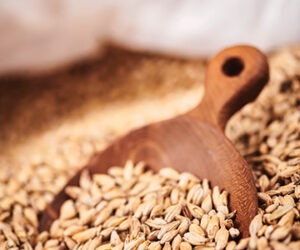Reading the Malt Specs
Malted Barley is a biological product, so it varies from year to year and batch to batch. This can affect your recipes and brewing procedures. You can learn the specifics of your malt by reading the malt analysis sheet.
Whether you brew at home or at the office, the more you know about the malt you use, the better and more consistent your beer will be. No two batches of malt are exactly alike and the only sure way of predicting the malt’s impact on your beer is to know how to read a malt analysis sheet. The information available for different malts varies with suppliers. Some only supply a typical malt analysis. Other malting companies offer a lot-specific analysis. At the minimum, every lot analysis sheet should list color, moisture content, extract and protein levels.
Color of the Malt:
Color reflects the level to which your malt has been kilned or roasted. This affects both color and flavor and as such is a good indication for what type of beer the malt is best suited. The color of any malt will vary from lot to lot due to production differences, crop variation and barley variety. In the United States, color is expressed in degrees Lovibond. In Europe, color is measured according to the standards of the European Brewing Convention and is expressed as EBC units.
Colors are not standard from one malt manufacturer to the next. This is why it is so important that you adjust your brewing not only according to the color reported on the lot analysis, but also to the flavor contribution that an individual malt will bring to your batch of beer.
Moisture Content:
Moisture content in malt generally reflects the quality of the malting itself. Malt with high moisture content may have been poorly malted or kilned. Malt moisture content that falls within the 3.5–6% range is acceptable. Malt with a moisture content over 6% is more susceptible to mold and off-flavor creation. As a general rule, you do not want to have pay for extra water in your malt.
At the same time, malt that is too friable (too low in moisture) can easily shatter. Pay close attention to the malt you receive from your supplier to make sure that it is within an acceptable range. You cannot dry moist malt out in the oven as you would risk further damaging the malt, specifically killing the enzymes and potentially discoloring the malt.
Extract Potential:
Malt analysis sheets usually list several indicators of extract potential, including FG, CG and the F/C ratio. Fine-grind (FG) extract percentage indicates the maximum soluble yield possible from the malted barley. The higher the FG extract, the more soluble the malt will be. Typical FG is approximately 80%. These numbers are usually given on an as-is basis. This means the malt includes moisture as opposed to a dry-basis analysis. This is more useful since brewers weigh out the malt with its moisture intact.
Coarse-grind (CG) extract will give you a good indication of what the grain underwent during malting and it will typically more closely approximate actual brewhouse results. CG Extract should be around 78%.
The fine/course (F/C) difference indicates the modification of the malt, how far the sugars in the barley have been modified during malting. “Steely” malt destined for a step-mash should have a targeted fine-coarse difference of 1.8–2.2% while “mealy,” well-
modified malt is best suited for an infusion mash and will have a targeted difference of 0.5–1.0%. Steely and mealy are used to describe the appearance of the endosperm (the very tip of the malt kernel). As a brewer, you will want to know how well the malt will crush and how accessible the endosperm will be to mash enzymes. The better and more extensive the malting, the higher percentage of mealy kernels.
Protein Level:
Protein is important because it is largely responsible for run-off difficulties in the brewhouse and haze in the finished beer. When brewing all-malt beer, it is preferable to use malt with a total protein level of less than 13%. Higher level of proteins can lead to haze in your finished beer.
Soluble protein is the amount of protein available in soluble form, expressed as a percentage of malt weight. In other words, this is the percentage of protein that will dissolve into the water during the mash. The greater the modification of the malt, the higher the proportion of soluble protein. The better the protein modification, the fewer problems you should have with protein-related difficulties. Typical soluble protein levels for base malt should be in the 5% range.
The S/T ratio is the ratio of soluble protein to total protein. This is an important indicator of malt modification. Malts with an S/T ratio of 36–42% are best used in a decoction mash because they are undermodified. Typical S/T ratios for base malt should be in the 50% range and can be used in any kind of mash.
Diastatic power (DP) expresses the levels of starch-reducing enzymes in the malt. A DP rating of 125 °Litner is typical in North American base malt. British ale malts are usually rated at 45° Lintner while lager malts are often rated at 65° Lintner.
By understanding and utilizing the basics of malt analysis sheets, you are well on your way toward brewing more consistent beer.



